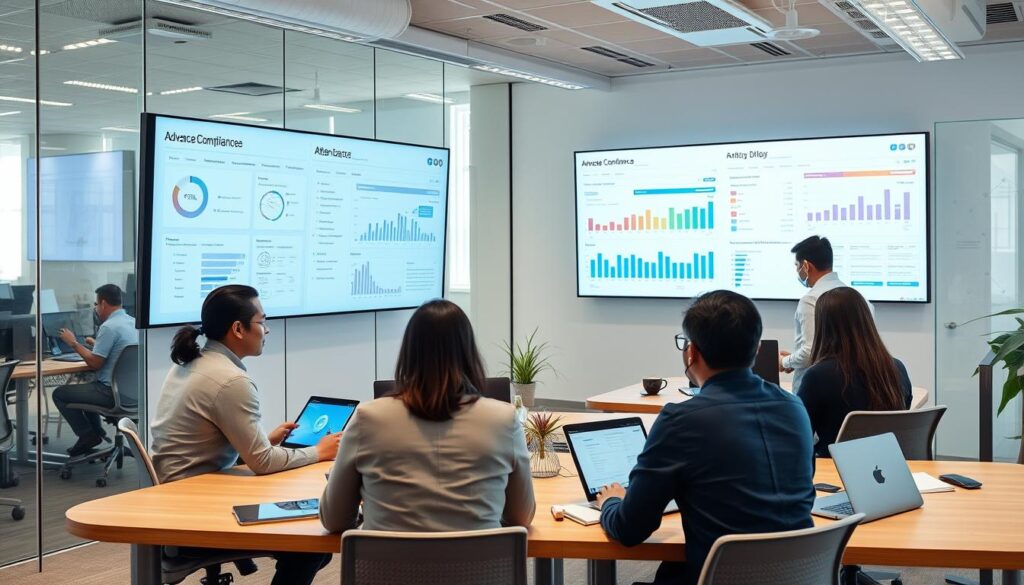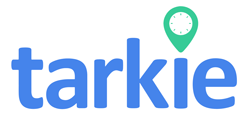As small and medium enterprises (SMEs) in the Philippines grow, do you know the cost of manual attendance tracking? Automation is changing the game, and old ways can cost you time and money. Switching to automated systems can improve your team management and boost morale.
Automated systems are now a must for businesses to succeed under strict rules. With tools like truMe’s attendance management, you can make your compliance work easier and more accurate. This helps you follow labor laws better and work more efficiently, key for SMEs looking to grow.
Key Takeaways
- Automated attendance systems significantly improve accuracy in tracking employee hours.
- Shifting to digital solutions can lead to a reduction in operational costs by 30%.
- Employee engagement scores may rise by 40% with improved self-service features.
- Automation minimizes errors, reducing payroll discrepancies and enhancing compliance.
- Scalable systems support business growth without needing extensive upgrades.
- Feedback and goal-setting tools foster higher productivity among employees.
- Automation can save HR managers up to 30% of their time currently spent on manual tracking.
Understanding Attendance Compliance for SMEs
Attendance compliance is key for small businesses to follow labor laws and their own rules. It’s important to track employee hours, leaves, and overtime accurately. This helps SMEs in the Philippines avoid legal problems and work more efficiently.
About 70% of SMEs still use old ways to track attendance. This can lead to mistakes and risks. But, using compliance software can make things better.
Automated systems can improve tracking by 50%. This makes keeping records easier and helps HR focus on important tasks. They don’t have to spend too much time on attendance anymore.
Cloud-based systems give businesses real-time data, boosting efficiency by 40%. Tools like biometric systems and RFID reduce errors and improve security. These tools help prevent time theft and ensure accurate attendance.
Choosing the right compliance software is crucial for SMEs. It helps them track attendance well and keep up with labor laws. This approach benefits everyone, creating a fair and open work environment.
Common Challenges in Manual Attendance Tracking
Manual attendance tracking can be a big problem for businesses. It often leads to errors in data entry, causing payroll issues. This can hurt employee trust and satisfaction.
On average, employees waste about 7 minutes per day on manual time tracking. This adds up to around 29.16 hours per year. For someone making $12 an hour, this means a yearly cost of about $350. A team of 5 would face an annual cost of $1,750, and 20 employees would cost up to $7,000.
Another big issue is time theft, like buddy punching. It can lower morale and cost money. Manual systems also lead to compliance risks and can waste a lot of time.
![]()
Hand-keying timesheets can lead to over or under payments. This can cause fines and a lot of time spent on corrections. With changing FLSA rules, tracking overtime has become more complex, adding to costs.
Supervisors often spend too much time on timesheets. This takes away from their ability to serve customers and make money. Over 260 hours are wasted each year due to these errors and questions.
To solve these problems, many businesses are looking at automated attendance solutions. These can improve payroll accuracy and make workforce management more efficient.
| Challenge | Impact on Business |
|---|---|
| Data Entry Errors | Payroll discrepancies eroding employee trust |
| Time Theft | Financial losses and decreased morale |
| Compliance Risks | Potential fines and operational inefficiencies |
| Time-Wasting Procedures | Over 260 hours lost annually on manual tasks |
| Supervisor Time Spent | Diminished focus on customer service activities |
Integrating timekeeping software with payroll systems can solve these problems. It streamlines processes and improves compliance for SMEs. Automated attendance systems provide reliable tracking, reducing manual work and improving management.
Why Automation is Key for Attendance Management
Automation is changing how we manage attendance, helping small and medium enterprises (SMEs) a lot. Automated systems make tracking attendance more accurate and efficient. For example, they can cut down payroll errors by 90%, making sure employees get paid right and on time.
Automation also helps reduce absenteeism by about 30%. This means companies can better manage who’s there and who’s not. Better attendance tracking leads to a more reliable and productive workforce.
Another big plus is following labor laws better. Automated systems can improve compliance by up to 40%. This lowers the risk of legal trouble, making operations safer. Plus, using real-time data helps spot patterns and peak times for productivity.
- Automated systems save SMEs about 60% of time each month on attendance tasks. This lets HR teams focus on more important things.
- These systems can be up to 50% cheaper for small businesses. They cut down on manual work and paper use a lot.
- GPS-based tracking lets companies reach a wider range of employees, expanding their workforce by 25%.
Companies that use automation for attendance see a 20% increase in keeping employees. This is because payroll is more accurate and employees are happier. Getting rid of manual work makes things more efficient and saves money by avoiding overpayment and untracked absences.
| Benefit | Estimated Impact |
|---|---|
| Reduction in payroll errors | 90% |
| Decrease in absenteeism rates | 30% |
| Improved compliance with labor laws | 40% |
| Increased workforce retention | 20% |
| Time savings for HR management | 60% per month |
Adding automation to attendance management makes things smoother and sets the stage for better workforce management. As businesses use these technologies, they’ll see ongoing benefits that help them grow and work more efficiently.
Benefits of Automated Attendance Systems
Automated attendance systems bring many advantages to small and medium enterprises (SMEs). They help with accurate attendance tracking and better workforce management. One key benefit is their ability to cut down on errors from manual tracking.
Manual tracking can lead to mistakes that affect payroll. This causes confusion for both employees and managers. Automated systems help avoid these issues.
Another big plus is the reduction of time theft. Traditional methods struggle to catch employees not on site. Automated systems use biometric authentication to prevent this.

Time efficiency is also a big win. Automated systems save employees and HR about five hours each month. This lets them focus on more important tasks.
Productivity can jump by up to 30% with these systems. This is because they make tracking easier and more accurate.
Compliance is another area where automated systems shine. SMEs see a 70% increase in following labor laws with these systems. This helps avoid legal trouble and builds trust in the workplace.
These systems also give managers real-time data on attendance. This helps them make quick, informed decisions. With automated systems, HR’s workload drops by 40% thanks to employee self-service.
In short, automated attendance systems do more than just track hours. They change how SMEs manage their workforce. They lead to better compliance, more productivity, and a more engaged team.
Essential Features of Attendance Compliance Software
Choosing the right compliance software is key for small and medium enterprises. It helps manage employee attendance well and boosts productivity.
Biometric authentication is a top choice for security. It stops buddy punching and tracks hours accurately. Mobile access lets employees clock in and out from anywhere. This supports remote work and increases accountability.
Good reporting is vital in compliance software. It lets management see attendance trends and real-time data. This helps make better decisions.
Flexible approval for timesheets can make admin work 25% more efficient. Integrating attendance tracking with payroll cuts errors by 40%. It ensures employees get paid right and on time.
Effective attendance compliance software makes managing the workforce better. Automation saves time and cuts costs. This lets SMEs focus on growing and developing.
How Automated Systems Improve Workforce Management
Automated systems are changing the game for small and medium enterprises (SMEs). They make managing employees easier and less prone to mistakes. This is key for keeping track of work hours and following labor laws.
Tracking attendance manually can be a big headache for managers. It takes away from important HR work. But, automation fixes this by taking over these tasks.
The global time and attendance software market is growing fast. It’s expected to hit $8.3 billion by 2032, with a 12.1 percent annual growth rate. This shows more businesses are seeing the value in efficient employee management.
Automated systems offer many benefits:
- Reduction of administrative load: They make daily tasks smoother.
- Minimization of compliance risks: They remind businesses about labor laws, keeping them legal.
- Improved accuracy: They cut down on mistakes in attendance and pay.
- Enhanced employee engagement: Employees can handle their own time and attendance better.

About 25% of companies use automation in HR, and it’s working. They’re seeing better efficiency and saving time. Automated systems give real-time data, helping businesses make quick, informed decisions.
| Benefit | Description |
|---|---|
| Improved Accuracy | Reduces errors in tracking and pay. |
| Time Savings | Less time on paperwork means more for HR. |
| Enhanced Compliance | Alerts businesses to law changes, avoiding fines. |
| Employee Empowerment | Self-service tools engage employees in their work. |
| Real-Time Insights | Gives data for better workforce decisions. |
In short, automated systems are a game-changer for SMEs. They boost efficiency, accuracy, and employee happiness. They also cut down on paperwork for HR.
Streamlining Payroll Processing with Automation
Automated systems have changed payroll processing, helping small and medium enterprises a lot. By using automation in payroll, businesses can save a lot of money. The American Payroll Association says this can cut costs by up to 80%.
This means businesses can focus more on growing and less on paperwork. It’s a big win for them.
Keeping payroll records accurate is key. The Fair Labor Standards Act requires keeping these records for at least three years. Automated systems make it easy to store and find these records.
Small businesses often make mistakes in payroll, with errors around 25%. These errors can cost a lot, like fines from the IRS. Automated systems help avoid these mistakes, saving money and avoiding penalties.
Automated payroll systems also help keep employees happy. They make sure everyone gets paid on time, which can lower turnover rates.
Many automated payroll solutions work with over 300 partners. This makes it easier to work with other software. It’s important to keep payroll information safe, so businesses use SSL technology and encryption.
The effect of automation on payroll is huge. Companies using these systems see a 35% drop in payroll problems. They also see a 200% return on investment in the first year, thanks to saved time and money.
Automating payroll can save businesses about 5 hours every pay period. This lets them focus on more important tasks.
About 40% of small businesses choose to outsource payroll. Using automated systems boosts employee happiness and ensures accurate payroll. This change makes payroll processing better, more efficient, and more compliant.
The Role of Technology in Workforce Optimization
Technology plays a big role in making workforces better by making things more efficient and accurate. It helps track employee hours well, reducing mistakes from old ways. Companies using this tech see a 30%+ boost in their return on investment, showing it works well.
Modern systems are great because they update in real-time. This cuts down on employees not showing up for work, which is a big problem. Sending reminders a few hours before work helps get more done, making the team more reliable.
These systems also let managers see everyone’s schedule at once. This helps teams work better together, no matter where they are. Some companies see a 40% jump in productivity thanks to these tools.

These tools also help track employee time, which is key for payroll and following labor laws. This helps manage costs better, avoiding too many or too few workers. It lets businesses plan better, making work more efficient.
In the end, using technology and compliance software helps small businesses in the Philippines work better. It creates a place where everyone trusts each other more. This makes employees happier and helps keep customers coming back, which is crucial in today’s market.
Implementing SME Solutions for Attendance Tracking
To set up SME solutions for tracking attendance, businesses need a solid plan. First, they must figure out what they need, from simple tracking to complex payroll systems. Tools like Buddy Punch and Clockify are great because they work from anywhere with internet.
By using these systems, companies can cut down on mistakes related to attendance. For example, XYZ Enterprises saw a 20% drop in errors after switching to a cloud-based system. These systems also help follow labor laws by keeping accurate records.
- Automated shift allocation cuts down on scheduling work.
- Real-time attendance data makes it easier for managers to see how productive their teams are.
- Linking attendance to payroll makes paying employees more accurate.
- Features that let employees manage their own time save HR a lot of work.
It’s important to train employees well when introducing new tools. Good training helps teams use new tools effectively. This is key to getting the most out of automation.
Adding features like GPS tracking and geofencing makes attendance tracking more accurate. Many companies see a 40% boost in reporting accuracy when they link attendance systems with project management tools. This helps make better decisions about staffing and resources.
| Feature | Benefit |
|---|---|
| Automated Shift Allocation | Reduces administrative burden |
| Real-time Attendance Data | Optimizes workforce productivity |
| GPS Tracking | Enhances accuracy and accountability |
| Employee Self-service | Saves HR departments significant hours monthly |
| Integration with Payroll Systems | Ensures precise employee compensation |
With these tips, SMEs can choose the best attendance tracking systems. Embracing automation is essential for improving operations and efficiency. Companies that use these solutions will stay ahead in a fast-changing work world.
Real-Life Examples of Automation in Filipino SMEs
In the Philippines, many small and medium-sized enterprises (SMEs) have started using automation. They use technology to manage their workforce better and follow attendance rules. These businesses are in different fields like retail, services, and construction.
For example, EasyHR is working on a new feature. It will help with important paperwork by December 1, 2024. This shows how automation helps businesses follow rules and avoid mistakes.
Cloud EasyPOS is a POS system that costs ₱9,000 a month. It lets businesses have unlimited users and manage items and inventory well. This helps SMEs work more efficiently and productively.
HII is also launching a new tool called easyHQ. It will be ready for supervisors and managers by December 1, 2024. This tool lets leaders check sales info from anywhere in the world, helping them make smart choices.
SMEs are very important in the Philippines. They make up 99.5% of all businesses and give jobs to over 65.1% of people. Using automation saves money and makes businesses more efficient.
The way businesses are changing shows their commitment to growth. They are moving to platforms like easyfis.com to easyfs.ph. This focus on digital and automation helps SMEs grow and stay strong, even when the market changes.
Attendance Compliance, Automation, SME Solutions: A Comprehensive Approach
In the world of attendance compliance, automation is a game-changer for small and medium-sized enterprises (SMEs). By adding automated systems to their workflows, these businesses can better follow labor laws and work more efficiently. This approach also helps keep employees motivated, allowing companies to focus on their main goals.
Automated attendance systems offer real-time data on who’s working. This helps businesses track productivity and how resources are used. For example, automated time tracking systems can record both online and offline hours. This makes payroll more accurate and reduces the chance of legal problems from wrong payments.
| Feature | Benefits |
|---|---|
| Real-Time Attendance Tracking | Ensures accurate data for improved compliance and decision-making |
| Smart Alerts | Identifies attendance patterns and potential issues early |
| Biometric Systems | Enhances security and reduces inaccuracies linked to manual methods |
| Mobile Applications | Facilitates ease of use for employees, encouraging consistent tracking |
| Integrated Reporting | Provides actionable insights for workforce optimization |
Understanding attendance patterns is key to workforce optimization. It helps businesses schedule work better and use resources wisely. For instance, knowing when employees are most productive can help plan work hours. Also, tackling issues like absenteeism can make the workplace better and more harmonious, boosting efficiency.
Using automated attendance systems can save SMEs a lot of money in the long run. It cuts down on administrative work and moves away from old methods. These systems can grow with a business, ensuring they keep working well without needing too much manual help. Automation is now within reach for SMEs, helping them stay compliant and efficient.
Future Trends in Attendance Management Technologies
The digital world is changing fast, and so is how we manage attendance. Technology like artificial intelligence and machine learning will make tracking attendance better. Small and medium businesses will use tools to predict when they need staff and adjust schedules.
This will help avoid problems and make work more efficient. It’s a big win for businesses.
More people are working from home, so we need better ways to track attendance. New tech like biometric verification and GPS tracking will help. This change will help businesses with remote workers and keep attendance records safe.
Soon, systems will be easier to use, making work for HR teams less stressful. Research shows that making leave requests easier can save up to 60% of time. This shows how important technology is for making work smoother.
Automated systems will keep track of who’s where and when. This helps businesses see patterns in how people work. About 70% of companies using this info say it helps them use resources better.
Businesses want to save money, so they’re moving to cloud-based systems. These systems are growing fast, with a 10-15% annual increase. Adding mobile features will make employees feel more connected, improving engagement by 40%.
In short, the future of managing attendance is all about using the latest technology. With better analytics and solutions for remote work, businesses can handle their workforce better.
Conclusion
Automation makes managing attendance easier for SMEs in the Philippines. It moves away from old ways to new, automated systems. This change helps solve common problems and makes tracking more accurate and efficient.
Studies show that errors can drop by up to 40%. This leads to a 75% boost in attendance record accuracy. Automated systems are key to this improvement.
Automated systems also let businesses watch attendance in real-time. This helps solve issues fast and cuts payroll mistakes by 30%. By using these solutions, companies can work better and make employees more responsible for their time at work.
Automation saves time and makes things easier to access. Even though it might cost a bit at first, the benefits are worth it.
Looking ahead, new tech like biometric recognition will likely become more common. AI and machine learning will make tracking even better. For SMEs, using these technologies is crucial to stay ahead and support employee growth.
